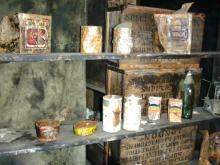What Are They Doing?
 Seismic station on the ice
Seismic station on the ice
Antarctica plays a central role in global tectonic evolution. Competing theories have been put forward to explain the formation of the Transantarctic Mountains (TAMs) and the Wilkes Subglacial Basin (WSB), primarily due to a lack of information on the crustal thickness and seismic velocity of these areas. The research team has attempted to resolve how the TAMs and WSB originated and how their formation relates to Antarctica's geologic history. Since most of Antarctica is covered by large ice sheets, direct geologic observations could not be made; therefore, "remote sensing" methods like seismology had to be used to determine details about the earth structure.
The goal of this project, funded by the National Science Foundation, was to broaden our knowledge of geology in this region with a new seismic array; the Transantarctic Mountains Northern Network (TAMNNET), a 15-station array across the northern TAMs and the WSB that helped fill a major gap in seismic coverage. Data from TAMNNET was be combined with that from previous and ongoing seismic initiatives and was analyzed to generate an image of the seismic structure beneath the TAMs and the WSB.
While in the field, the team spent most of their time servicing the seismic stations that compose the new TAMNNET array. This included loading equipment onto small airplanes, flying to remote field locations, uncovering the deployed equipment, and checking for any maintenance issues. The first batch of data from the network was also retrieved during this time.
Where Are They?
 View of the Transantarctic Mountains
View of the Transantarctic Mountains
The field project was primarily based at McMurdo Station, with some work conducted from the Italian Terra Nova station, Mario Zuchelli. Seismic stations were installed at remote sites across the northern Transantarctic Mountains and onto the East Antarctic plateau in 2012. In the 2013 season, those stations were revisited for servicing and for collecting the first batch of data. Once in Antarctica, the field locations were reached either via helicopter or fixed-wing Twin Otter Aircraft. The field team shared dormitory housing. Fieldwork was conducted outside at cold and (in some cases) fairly high altitude conditions.
Latest Journals

Samantha Hansen is an assistant professor at the University of Alabama, where she researches fundamental earth science processes, such as mountain building, continental rifting, and craton formation. She employs a wide range of geophysical tools to analyze seismic data to investigate structure and infer associated geologic mechanisms. Over the past few years she has worked on several projects in Antarctica investigating the structure of the Transantarctic Mountains, the Gamburtsev Mountains, and the West Antarctic Rift System. She also has interests in earth science education and promoting underrepresented students in science. To read more about Dr. Hansen's work please visit her website.





